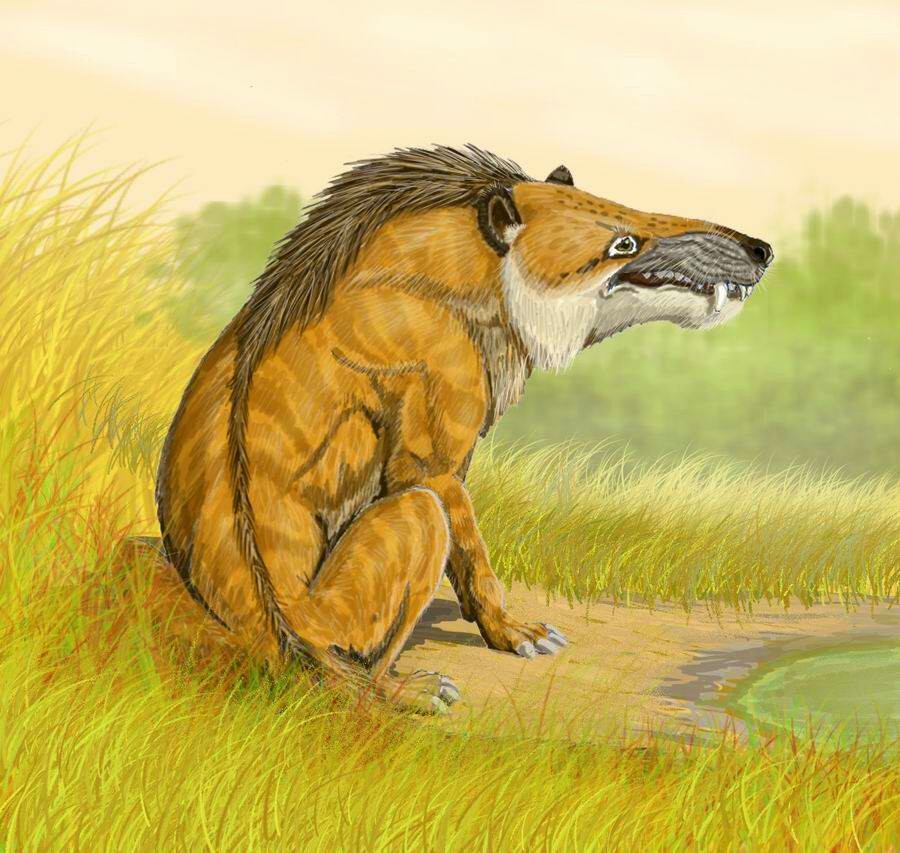- Andrewsarchus
Taxobox
name = "Andrewsarchus"
fossil_range = LateEocene

image_caption = Reconstruction of "A. mongoliensis"
regnum =Animal ia
phylum = Chordata
classis =Mammalia
ordo = †Mesonychia
familia = †Triisodontidae
genus = "†Andrewsarchus"
species = "†A. mongoliensis"
binomial = "†Andrewsarchus mongoliensis"
binomial_authority = Pao, 1923"Andrewsarchus mongoliensis" (pronounced ANN-drew-SARK-us), ("Andrews" + Greek "ἀρχός", "ruler"), was a basal, heavily-built, wolf-like,
hoof edmammal that lived during theEocene epoch, roughly between 45 and 36 million years ago. It walked on four short legs and had a long body, a long tail, and feet with hoofed toes. It had a long snout with large, sharp teeth and flat cheek teeth that may have been used to crush bones. Because "Andrewsarchus" is only known from a skull and a few bones found, whether it was an activepredator or merely a largescavenger is open to debate, as is its exact time range."Andrewsarchus" is named for the famous explorer and fossil hunter
Roy Chapman Andrews . It was discovered in June 1923 by Kan Chuen Pao, a member of Andrews' expedition, on a site in theGobi Desert inMongolia known as Irdin Mahna [variants: Erdeni-Mandal and Erdenemandal ('jeweled mandala')] on the third Asiatic expedition that was led by Andrews and sponsored by the American Museum of Natural History. The American Museum of Natural History is where the skull section of the fossil is now on display: the lower jaw was not found. It is classified in the OrderMesonychia due to the similarity in structure between its teeth and skull with those of other mesonychid species known from complete skeletons. As such, it is assumed that it had hoofed toes similar to those of "Mesonyx " or "Sinonyx ", and is regarded as a relative ofartiodactyl ungulates.Description
"Andrewsarchus" is known only from an enormous
skull (83 cm long and 56 cm wide) [Benton, M.J. (2005). "Vertebrate Palaeontology". Oxford, 333.] and pieces of bone, but the skull's similarity to that of smallermesonychid s suggests that "Andrewsarchus" had the same wolf-like body on a larger scale. It is possibly the largest land-dwelling carnivorous mammal known. "If "Andrewsarchus" was proportioned in the same manner as "Mesonyx obtusidens ", it had a length from the snout to the back of the pelvis of about convert|12|ft|m and a height from the ground to the shoulder or middle of the back of about convert|6|ft|m. Thus in round numbers it is possible that it may have been three times the size of "Synoplotherium (Dromocyon) vorax" or of "Mesonyx obtusidens"."cite journal | last = Osborn | first = Henry Fairfield | authorlink = Henry Fairfield Osborn | title = "Andrewsarchus", giant mesonychid of Mongolia | journal = American Museum Novitates | issue = 146 | publisher = The American Museum of Natural History | date = November 11, 1924 | url = http://digitallibrary.amnh.org/dspace/bitstream/2246/3226/1/N0146.pdf | accessdate = 2007-08-05 ] Further fossil finds should shed light on the size of the animal, as it is not known if the present specimen represents an average, or exceptional animal of the species. Nor does it specify its age.Paleobiology
The appearance and behavioral patterns of "Andrewsarchus" are virtually unknown and have been topics of debate among
paleontologist s ever since it was first discovered. All that is known about "Andrewsarchus" comes chiefly from the single, nearly perfectly, preserved three-foot-long skull found in Late Eocene sediments in what is now Mongolia. New theories indicate that the teeth of "Andrewsarchus" may have been blunt and uncharacteristic of predators. Its diet could have been moreomnivorous thancarnivorous , consisting ofcarrion , bones, rooted plants, ormollusk s rather than freshly killed meat. As a scavenger, "Andrewsarchus" may have gained access to freshly killed carcasses by using its formidable size to scare away other smaller predators and scavengers. Until more fossil evidence that may provide insight into these areas of uncertainty is uncovered any reconstructions remain highly speculative. "Andrewsarchus" possessed some of the strongest jaws ever evolved in a land mammal, able to bite through large bones if needed. To judge from its immense jaws, and the coastal location of thefossil s, "Andrewsarchus" may have fed on beached primitive whales,shellfish and hard-shelledturtle s, and contemporary large mammals at various periods during its existence. Toward the end of the Eocene very large mammals (such as thebrontothere s) had evolved in the region of Central Asia.Despite the enormous jaws and very sturdy teeth, "Andrewsarchus" did not have teeth adapted for the
carnassial shear, though its immensely powerful jaws rendered such an adaptation unnecessary. Judging by its sheer size, the animal most likely fed on large animals such as the extinct brontotheres, which were among the largest herbivorous mammals at the time, possibly both hunting them, and scavenging already dead carcasses.Due to the food requirements of "Andrewsarchus", abundant sources of large animals are thought to have been present in Central Asia during the Eocene, most likely on a year-round basis. When the
Indian subcontinent collided with Asia during the LateEocene /EarlyOligocene , this event caused the formation of theHimalaya mountains while closing off the easternTethys Ocean , thus changing weather patterns, and caused Central Asia dry out, ultimately resulting in a dramatic faunal turnover. It is suggested that "Andrewsarchus" became extinct due to thisorogeny .Fact|date=November 2007References
External links
* [http://www.johnsibbick.com/window/andrew.asp Artistic reconstruction] The artist shows the creodont "
Sarkastodon " in the background, waiting forAndrewsarchus to finish feeding on the carcass of a recently deceased "Embolotherium ". The deadbrontothere shown would have been about the size of a modernrhinoceros . Aprimate can be seen on a tree branch, and an early member ofCarnivora , which eventually became the dominant land predators, is seen in the foreground.
* [http://www.museon.nl/NR/rdonlyres/4E472C03-5D20-46B6-8416-C7F8B260BC21/2211/JWMWAndrewsarchus01.jpgLifesized model]
Wikimedia Foundation. 2010.
